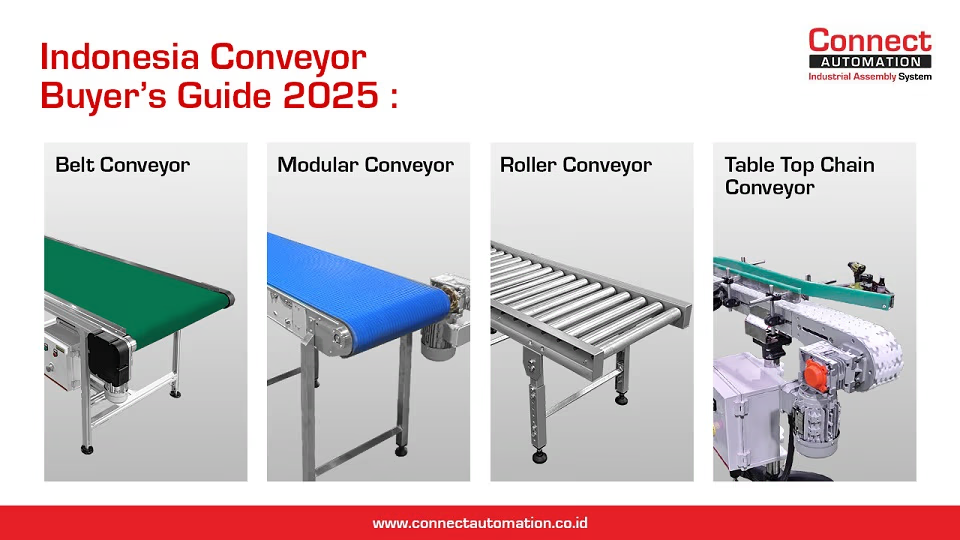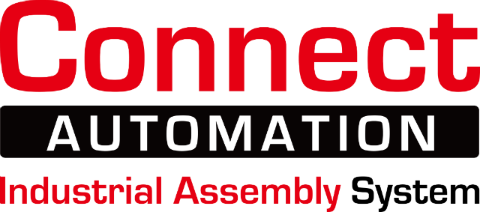PT. Environeer
031-99858624 (Surabaya), 021-8935060 (Jakarta)
REQUEST A FREE ESTIMATE!
Conveyor Indonesia 2025: Belt vs Roller vs Modular vs Table-Top

Who this guide is for
Factory managers, project engineers, and maintenance leads in Indonesia who need a practical, vendor-agnostic way to choose the right conveyor type, with fast internal justification.
TL;DR (decision snapshot)
- Hygiene first? Start with belt (PU/PVC) or modular; minimize crevices and pick clean-in-place options.
- High accumulation & gentle handling?MDR (powered roller) with ZPA logic shines.
- Curves & reconfiguration?Modular belt and table-top chain handle curves best.
- Cost & speed simplicity?Gravity or lineshaft roller for low-complexity moves; belt for steady transport.
The four conveyor families, at a glance
| Keluarga | Unggul Untuk | Kecepatan | Higienitas | Kemampuan kurva | Catatan |
|---|---|---|---|---|---|
| Belt (PVC/PU) | General transport, inclines, light washdown | Low–Med | ★★★☆ | Straight | Smooth surface, great for mixed SKUs, many belt materials |
| Modular belt | Curves, drains, washdown, impact | Low–Med | ★★★★ | Sangat Baik | Easy repair by links, good for food plants |
| Roller | Cartons/totes, accumulation, buffering | Low–Med | ★★☆☆ | Straight | MDR enables ZPA, energy-efficient, low back-pressure |
| Table-Top Chain | Bottling, packaging, tight curves | Med–High | ★★★☆ | Excellent | Smooth chain links, common in FMCG & beverage |
Selection path — 10 questions that narrow the field
- Product & package (rigid, flexible, wet, oily, hot, sharp edges?).
- Throughput target (cph/cpm) and takt time.
- Pitch (product length + gap/back-pressure).
- Required accumulation (by parts or seconds).
- Cleanliness (BPOM/HACCP expectations, washdown, splash zones).
- Layout constraints (curves, inclines, L/Z transfers, floor drains).
- Contact surface (scuff risk, labels, film overhangs).
- Environment (temperature, chemicals, steam, dust).
- Controls (start/stop logic, ZPA, photoeyes, safety PLC).
- Service & spares (lead time in Indonesia, standard components).
Belt vs Modular vs Roller vs Table-Top — where each wins
Belt Conveyor- Use when: steady transport, inclines, mixed SKU sizes, gentle handling.
- Pros: many belt compounds; quiet; easy to clean; cost-effective.
- Watchouts: edge wear near side guides; belt tracking; water carryback.
- Use when:curves, washdown, debris/drainage, impact loads.
- Pros: quick link repairs; wide curves; positive drive.
- Watchouts: link hinge lines can trap fines—spec proper cleaning; larger turning radius than table-top.
- Use when:accumulation, tote/carton flow, buffering to case packers/palletizers.
- Pros: MDR gives zero-pressure accumulation; energy-efficient; flexible cells.
- Watchouts: not ideal for very small or flexible packs; noise without good guarding and maintenance.
- Use when:bottling/packaging with tight curves and synchronized transfers.
- Pros: smooth link-to-link transitions; common parts; compact curves.
- Watchouts: return-side noise; needs correct wear strip & lubrication strategy.
Hygiene & compliance (BPOM/HACCP) essentials
- Materials & finish: prioritize SS304 contact surfaces, food-grade PU belts, rounded frames, sealed fasteners.
- Cleanability: tool-less belt removal/flip-up tails, drip pans, sloped surfaces, no horizontal ledges.
- Splash/wash zones: IP-rated motors/gearboxes, stainless fasteners, food-safe lubricants, correct cable glands.
- Docs for audit: material certs, belt data sheets, lube list, cleaning SOP, risk assessment.
Throughput & speed — quick math you’ll actually use
- Pitch (mm) = product length + gap/back-pressure allowance.
- Belt speed (m/min) ≈ pitch (mm) × parts per minute ÷ 1000.
- Buffer length (m) = pitch × buffer parts ÷ 1000 or pitch × (cpm × buffer seconds / 60) ÷ 1000.
Typical use-case patterns
- Receiving → QC → Put-away: gravity or lineshaft roller + short MDR zones for merges.
- Primary packaging (food): belt or modular belt; add quick-release belt & washdown hardware.
- Bottling & canned drinks: table-top chain with accumulation and starwheels at infeed/outfeed.
- E-commerce totes: MDR ZPA cells with photoeyes and diverts; low noise, low back-pressure.
What to include in your RFQ
- Product dims & weight range; temperature & surface condition (wet/oily).
- Target throughput & takt; pitch and buffer (parts or seconds).
- Hygiene level (HACCP/BPOM); washdown frequency; cleaning chemicals.
- Layout (curves, inclines, transfers), space limits, utilities.
- Controls (start/stop logic, ZPA, sensors), safety (guards, E-stops).
- Spare parts expectation and lead-time requirements in Indonesia.
About Us
Connect Automation specializes in providing automation solutions, including conveyor systems, to improve efficiency across various industries. The company delivers cutting-edge technology to help organizations automate tasks and optimize workflows. Connect Automation helps businesses reduce manual efforts, boost productivity, and achieve better outcomes. With a customer-focused approach, the company designs tailored solutions to ensure smooth and effective automation transitions for long-term success.
Connect Automation specializes in providing automation solutions, including conveyor systems, to improve efficiency across various industries. The company delivers cutting-edge technology to help organizations automate tasks and optimize workflows. Connect Automation helps businesses reduce manual efforts, boost productivity, and achieve better outcomes. With a customer-focused approach, the company designs tailored solutions to ensure smooth and effective automation transitions for long-term success.
Cikarang Office
Kawasan Industri Jababeka Tahap 1, Jl. Jababeka II D Blok C14L Cikarang, Indonesia (17530)
(021) 893 5060 Google Maps
Kawasan Industri Jababeka Tahap 1, Jl. Jababeka II D Blok C14L Cikarang, Indonesia (17530)
(021) 893 5060 Google Maps
Surabaya Office
Rungkut Industri III, No. 37, Rungkut Menanggal, Kec. Gn. Anyar Surabaya, Indonesia (60293)
(031) 9985 8624 Google Maps
Rungkut Industri III, No. 37, Rungkut Menanggal, Kec. Gn. Anyar Surabaya, Indonesia (60293)
(031) 9985 8624 Google Maps
